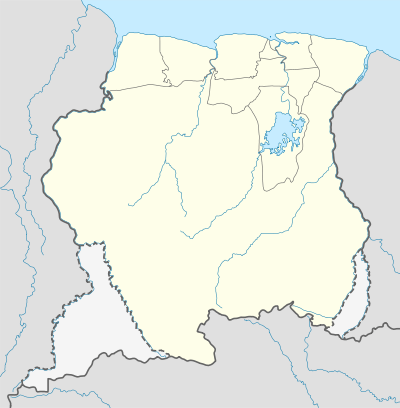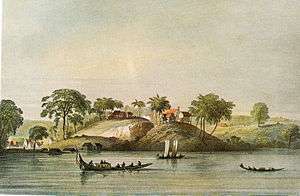Jodensavanne
 The remains of the Beracha ve Shalom ("Blessings and Peace") synagogue on the Jodensavanne (February 2000) | |
 Shown within Suriname | |
| Location | Para District, Suriname |
|---|---|
| Coordinates | 5°25′0″N 54°57′50″W / 5.41667°N 54.96389°WCoordinates: 5°25′0″N 54°57′50″W / 5.41667°N 54.96389°W |
| Type | Settlement |
Jodensavanne (Dutch, "Jewish Savanna") was an agricultural community in Suriname, South America established by Jews fleeing persecution in Spain. It was located in Para District, about 50 km (31 mi) south of the capital Paramaribo, on the Suriname River. Sugarcane plantations were established and slaves used. The colony faced an attack and heavy levies imposed by a French captain, competition with sugar beets, disease and revolts from indigenous people and slaves. The community eventually relocated to the capital of Paramaribo. Clearing of gravesites and maintenance of the synagogue ruins has taken place in the 21st century.
History

In 1639, the English government allowed Sephardi Jews from the Netherlands, Portugal and Italy to settle the area. They came first to the old capital Torarica. In the year 1652, a new group that migrated under the leadership of Lord Willoughby (Francis Willoughby, 5th Baron Willoughby of Parham) settled in the area now known as Jodensavanne. A third group came 1664, after their expulsion from Brazil and then French Guiana, led by David Cohen Nassy.
The Jewish community was granted some autonomy[1] and developed a sugar-cane plantation economy. European settlements including in the Jodensavanne were attacked by Carib (Kalina people) in the latter part of 1678 and slaves also revolted.[2]
The congregation Beracha ve Shalom ("Blessings and Peace") was founded, with the first wooden synagogue in the community (the 3rd synagogue in South America) built between 1665 and 1671 and a second, made of imported brick, was constructed in 1685.
Jodensavanne declined during the mid-18th century, and most of its population moved to Paramaribo. The colony strived to survive until it was destroyed in 1832 by a slave revolt and resulting fire. The location served as a camp for political prisoners in the Second World War.
Historian Natalie Zemon Davis is working on a history of 18th century Jodensavanne, focusing on David Isaac Cohen Nassy (born 1747) and relations between blacks and whites in the Jewish community.[3]
See also
References
- ↑ This Day in Jewish History by David B. Green Aug 17, 2014 Haaretz
- ↑ History, Power, and Identity: Ethnogenesis in the Americas, 1492-1992 edited by Jonathan D. Hill page 32
- ↑ Herschthal, Eric (17 August 2006). "A Star Historian Opens a New Chapter: Jewish Slaveowners". The Jewish Daily Forward. Retrieved 29 November 2011.
Further reading
- Remnant Stones. The Jewish Cemeteries of Suriname Ben-Ur, Aviva en Rachel Frankel Epitaphs, 2009 (Hebrew Union College Press)
- De groene hel. Een Nederlands concentratiekamp in Suriname A.G. Besier March 1, 1942 to July 15, 1946, Bunne 1994 (Uitg. Servo)
- De strafkolonie. Een Nederlands concentratiekamp in Suriname 1942 - 1946 Twan van den Brand Amsterdam 2006 (Uitg. Balans)
- Wreedheden in Kamp Jodensavanne. De groene hel Maaike Verschuren, Parbode, nr. 33, januari 2009, p. 46-48.
External links
- Jodensavanne Foundation
- Jews in Suriname at Haruth.com
- The settlement of Joden Savanne and Cassipora cemetery at UNESCO.org
- Penal colony at Jodensavanne(Dutch) at strafkolonie.nl
